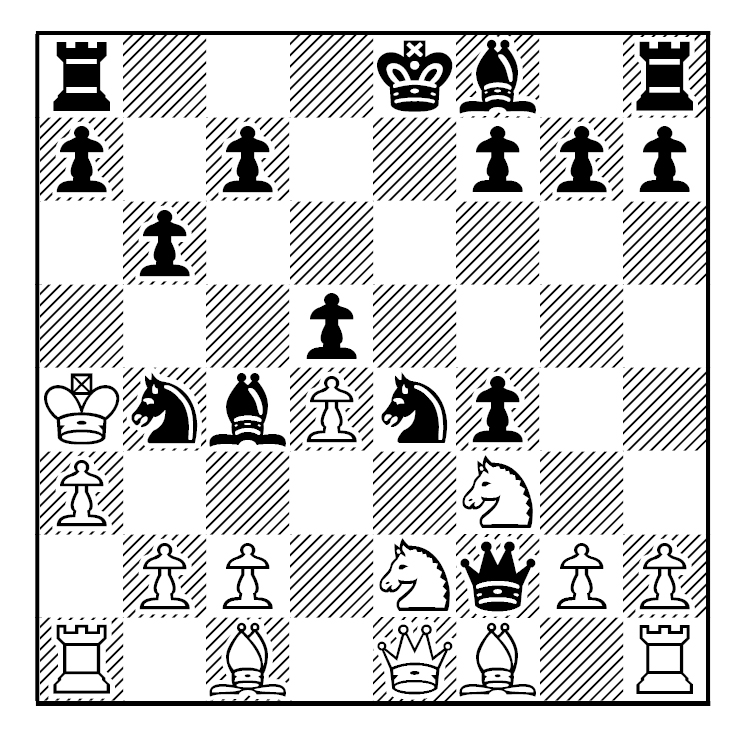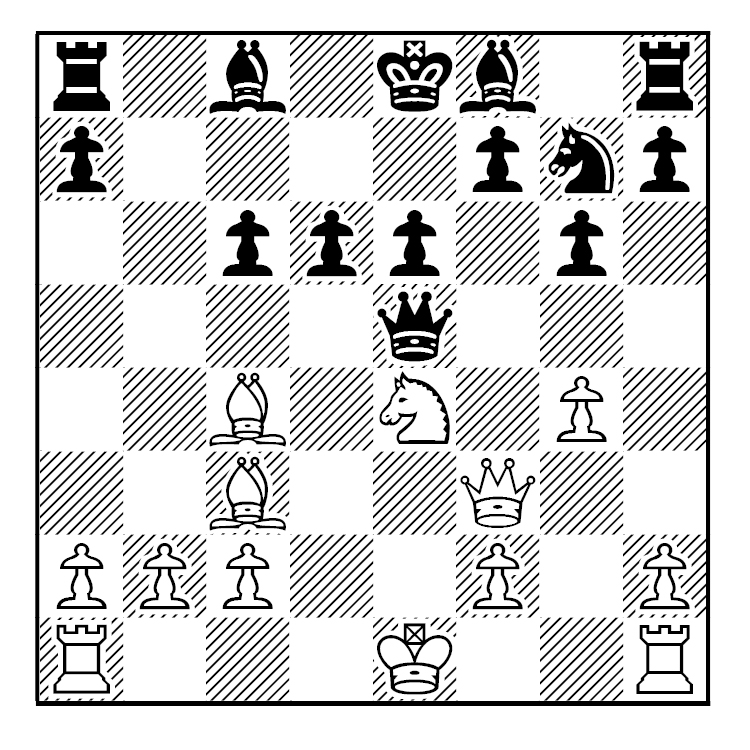The AMAR gambit is a rarity in chess.
First, let’s talk about the name of the gambit. Many players are convinced that AMAR is an acronym for Absolutely Mad And Ridiculous. And they are at least half correct, it is an absolutely mad and ridiculous opening. But the opening is named after Charles Amar, a 1930s player from Paris.
What makes this opening so bad? Well, the opening starts with 1.Nh3. And with this move White gives up his claim for the center, loses a tempo with his knight, and retards his own development.
Black probably has the advantage after either 1…e5 or 1…d5.
After 1.Nh3 d5, the game can continue with 2.g3 e5 3.f4, and the position of the AMAR gambit has been reached. Let’s see what White has done. With 2.g3 and 3.f4, he not only has the same problems as before, but has also tacked on a few more problems. His kingside is considerably weakened, he has open lines to his king, namely the d8-h4 diagonal (the same one used in Fool’s Mate), and he has sacrificed (lost?) a kingside pawn.
What has White gotten for all this mess? If Black plays 3…exf4, then White can win back the f-pawn with 4.Nxf4. He then has an OK position for his knight. And White can try castling.
Black, however, doesn’t have to play 3…exf4, leaving White with an entirely lost position. White can still try to castle kingside and maybe have some play along the f-file. But he usually doesn’t have the time to castle or make any long-term plans.
Really, White does better with the King’s Gambit.
~~~~~~~~~~~~~~~~~~~~~~~
AMAR Gambit
1) 3.f4
2) 3.f4 exf4 4.Nxf4
3) 3.f4 Bxh3
AMAR-1
3.f4
Black can decline the gambitted pawn. While there is nothing wrong with this approach, Black has stronger moves.
B.C. Allison-M.H. Stubbs
Australia Ch. (reserves)
Cooma, 1974
1.Nh3 d5 2.g3 e5 3.f4 e4 4.Bg2 Bc5 5.e3 Nf6 6.O-O Bg4 7.Qe1 Nc6 8.Nf2 Be6 9.c4 Nb4 10.Qd1 Qd7 11.cxd5 Bxd5 12.Nc3 Qe7 13.a3 Nc6 14.Nxd5 Nxd5 15.Nxe4 Bb6 16.b4 O-O-O 17.Qc2 Kb8 18.Rb1 Nf6 19.Nc5 Rd6 20.a4 a6 21.Nxb7 Kxb7 22.b5 axb5 23.axb5 Qd7 24.Qa4 Ra8 25.Bxc6+ Rxc6 26.bxc6+ Qxc6 27.Qxc6+ Kxc6 28.Bb2 Ne4 29.Rbc1+ Kd5 30.Rc2 Ra2 31.Rfc1 f6 32.Kf1 Ba5 33.Bc3 Nxc3 34.dxc3 Rxc2 35.Rxc2 Kc4 36.Rd2 Bxc3 37.Rd7 c5 38.Ke2 Kb3 39.Kd1 c4 40.Rxg7 Bb4 41.Rxh7 c3 42.Rb7 1-0
Arthur Stobbe (1835)-David Hillery (2274)
corres.
Golden Knights, 1999
1.Nh3 e5 2.g3 d5 3.Bg2 Nf6 4.f4 e4 5.Nf2 Bc5 6.e3 h5 7.d4 exd3 8.Nxd3 Bb6 9.Nc3 Bg4 10.Bf3 d4 11.Na4 Nc6 12.Nxb6 axb6 13.e4? Nxe4 14.Bxg4 hxg4 15.Qxg4 Qf6 16.O-O Kf8 17.b3 Qh6 18.Qe2 Nxg3 19.Qg2 Nxf1 20.Kxf1 Qxh2 21.Bb2 Ra5 22.a4 Rah5 23.c3 Rh3 24.Nf2 Qxf4 25.Qxh3 Rxh3 0-1
Stephan Mueller-Christoph Jablonowski
Oberliga Nord N 0506
Germany, Oct. 23 2005
1.Nh3 d5 2.g3 e5 3.f4 Bd6 4.fxe5 Bxe5 5.d4 Bf6 6.Bg2 Ne7 7.O-O Ng6 8.Qd3 O-O 9.Nd2 Be6 10.Nb3 Nd7 11.c3 Rc8 12.Be3 Be7 13.Na5 c6 14.b4 b6 15.Nb3 Nf6 16.Nf4 Bd7 17.Kh1 Qc7 18.Bg1 Rce8 19.Rae1 Bd6 20.Nh3 Ne4 21.Bf2 Bf5 22.Qf3 Qd7 23.Nf4 Bg4 24.Qd3 Bxf4 25.gxf4 Nxf4 26.Qe3 Nxg2 27.Kxg2 Nxf2 28.Qxf2 Bh3+ 29.Kh1 Bxf1 30.Qxf1 Re3 31.Qg2 Qf5 32.Nd2 Rd8 33.c4 Qg6 34.Qf2 Qc2 35.Rf1 f6 36.Nf3 Qxe2 37.cxd5 Qxf2 38.Rxf2 cxd5 39.Ng1 Rd3 0-1
AMAR-2
3.f4 exf4 4.Nxf4
Certainly Black can take the pawn. Well, he ends up with a much better position than White, who finds himself on the defensive. It is not known if this is a forced win for Black, but it is close to one.
N.N.-N.N.
British Jr. Ch., 1965?
1.Nh3 d5 2.g3 e5 3.f4 exf4 4.Nxf4 Bd6 5.d3 h5 6.Bg2 h4 7.e4 Nf6 8.Nc3 Bg4 9.Qd2 hxg3 10.hxg3 Rxh1+ 11.Bxh1 g5 12.Nfxd5 Bxg3+ 13.Kf1 Nxd5 14.Nxd5 c6 15.Qg2 Qd6 16.Nc3 Qf6+ 17.Kg1 Qd4+ 0-1
AMAR-3
3.f4 Bxh3
It took a while for Black to figure out the winning strategy. And that strategy to attack first, and then continue to attack, attack, and attack.
Tartakower-Lilienthal
Paris, 1933
1.Nh3 d5 2.g3 e5 3.f4 Bxh3 4.Bxh3 exf4 5.O-O fxg3 6.hxg3 Nf6 7.d3 Nc6 8.Nc3 Bd6 9.Bg5 Bxg3 10.Bxf6 gxf6 11.e4 Rg8 12.Nxd5 Be5+ 13.Kh1 Qd6 14.c3 Rg3 15.Qh5 Rxd3 16.Rad1 Rxd1 17.Rxd1 Ne7 18.Ne3 Qc5 19.Qxh7 Nc8 20.Qg8+ 1-0 (Forced is 20…Qf8 21.Rd8+ Kxd8 22.Qxf8#.)
H. Meyers-T. Alvarez
Dominican Republic, 1966
1.Nh3 d5 2.g3 e5 3.f4 Bxh3 4.Bxh3 exf4 5.O-O fxg3 6.e4 gxh2+ 7.Kh1 dxe4 8.Nc3 Nf6 9.d3 exd3 10.Bg5 dxc2 11.Qf3 Be7 12.Qxb7 Nbd7 13.Bxd7+ Nxd7 14.Bxe7 Kxe7 15.Nd5+ Kf8 16.Nxc7 Nc5 17.Ne6+ Nxe6 18.Qxf7mate 1-0
Harnett-Muller
Guernsey Open, 1980
1.Nh3 d5 2.g3 e5 3.f4 Bxh3 4.Bxh3 exf4 5.O-O fxg3 6.e4 gxh2+ 7.Kh1 dxe4 8.d3 Nf6 9.Nc3 exd3 10.Bg5 Be7 11.Qf3 O-O 12.Rae1 Nc6 13.Qg2 Nh5 (> 13…Kh8) 14.Bxe7 Nxe7 15.Bg4 d2 16.Re5 Nf6 17.Rxf6 gxf6 18.Rd5 Qb8 (> 18…Qxd5) 19.Rh5 Kg7 20.Qxd2 Rh8 21.Ne4 1-0
William Preston-Roelof Westra
Hull Congress Open, Sept. 14 1996
1.Nh3 d5 2.g3 e5 3.f4 Bxh3 4.Bxh3 exf4 5.O-O fxg3 6.e4 dxe4 7.d3 Bc5+ 8.Kh1 Qh4 9.Qg4 Qxg4 10.Bxg4 Nf6 11.Bc8 Nbd7 12.Bxb7 Rb8 13.Bxe4 Nxe4 14.dxe4 gxh2 15.Nc3 O-O 16.b3 Bd4 17.Bb2 Ne5 18.Rad1 c5 19.Kxh2 Ng4+ 20.Kg3 Ne3 21.Rxd4 Nxf1+ 22.Kf2 cxd4 23.Nd5 Ne3 24.Ne7+ Kh8 25.Bxd4 Nxc2 26.Bb2 Rbd8 27.Nf5 f6 28.Kg3 Rd3+ 29.Kf4 g5+ 30.Kg4 Ne3+ 31.Nxe3 Rxe3 32.Kf5 Re2 33.Ba3 Rf7 34.Ke6 Kg7 35.Kf5 h5 36.Bc5 h4 37.a4 h3 38.b4 h2 0-1
William Preston-A. Bulbeck
Hull Congress Open, Sept. 15 1996
1.Nh3 d5 2.g3 e5 3.f4 Bxh3 4.Bxh3 exf4 5.O-O Bd6 6.e4 fxg3 7.d4 Qh4 8.Qf3 Qxh3 -+ 9.Qxf7+ Kd8 10.Bg5+ Ne7 11.Rf3

11…Qxh2+ 12.Kf1 g2+ 13.Ke1 g1=Q+ 14.Rf1 Qxg5 15.Qf3 Qc1+ 16.Qd1 Qe3+ 0-1
Igor Glazyrin-Artur Gataullin
Russia U26 Ch.
Ufa, May 10 2004
1.Nh3 d5 2.g3 e5 3.f4 Bxh3 4.Bxh3 exf4 5.O-O fxg3 6.e4 gxh2+ 7.Kh1 dxe4 8.d3 Nf6 9.Nc3 exd3 10.Bg5 Be7 11.Qf3 Nc6 12.Rae1 O-O 13.Qg2 Kh8 14.Rxe7 Qxe7 15.Nd5 Qe2 16.Nxf6 Qxg2+ 17.Bxg2 h6 18.Bh4 dxc2 19.Kxh2 Nb4 20.Nh5 Nxa2 21.Nxg7 f6 0-1









